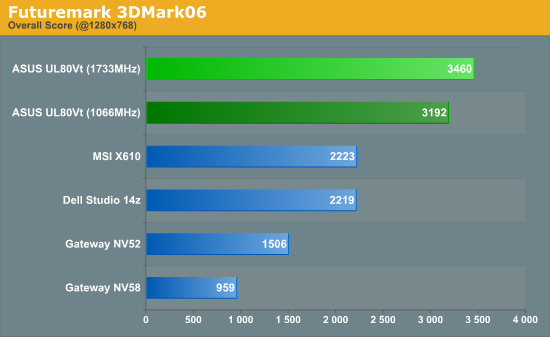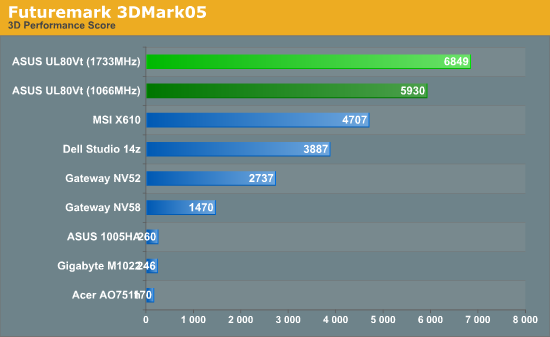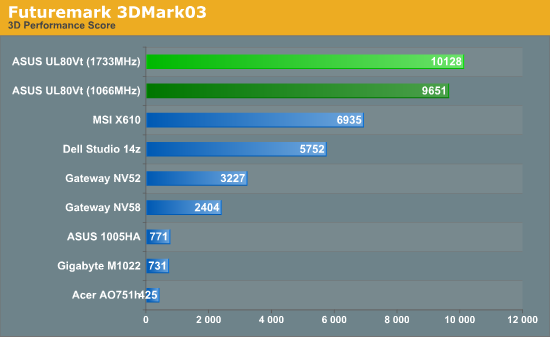ASUS UL80Vt First Look: Mobility Redefined
by Jarred Walton on October 24, 2009 8:00 PM EST- Posted in
- Laptops
ASUS UL80Vt Benchmarked - Graphics Performance
Our testing for now is confined to the use of the discrete GeForce G210M graphics on the UL80Vt. When we deliver our full review, we will include additional results using the integrated GMA 4500MHD. You can get a good idea of the 4500 MHD performance by looking at the Gateway NV58 results; the NV58 has a faster CPU, but for 3DMark and gaming performance the GPU is going to be a huge bottleneck.




Looking at 3DMark graphics performance, the G210M combined with the overclocked SU7300 delivers respectable performance. The G210M is clearly faster than the 9400M G integrated solution, with the advantage ranging from a low of 30% in 3DMark Vantage up to a high of 76% in 3DMark03. We realize 3DMark isn't true gaming performance, but most games correlate well with one of the versions. 3DMark06 and Vantage include CPU performance into the final score, which is why the gap between the 14z and UL80Vt isn't quite as large -- the P8600 should be at least 39% faster than the overclocked SU7300, and the detailed results confirm that. The CPU score in 3DMark06 is 1571 for the UL80 compared to 2117 with the 14z (a 35% advantage to the 14z), while the CPU score in Vantage is 3344 vs. 4284 for the 14z (28% faster). Meanwhile the 3D scores favor the UL80 by 58% in Vantage and 69% in 3DMark06. For reference, the Gateway NV52 with HD 3200 isn't even close in 3DMark; the UL80Vt is 130% to 214% faster!
Even at 1066MHz, the SU7300 with the G210M puts up a fight. The lead drops to 7.5% in Vantage (due primarily to the low CPU score), but it's still 44% in 06, 53% in 05, and 68% in 03. The comparison to the NV52 continues to be a landslide in favor of the SU7300+G210M: it's 105% faster in Vantage and up to 200% faster in 3DMark03.
We recognize that 3DMark isn't the be-all, end-all indicator of gaming performance, but as a quick test we can see that UL80Vt with the G210M enabled should never be slower than laptops with integrated graphics when it comes to gaming (i.e. the Dell 14z with 9400M G and the Gateway NV52 with HD 3200). It's also worth noting that the UL80Vt supports NVIDIA's reference drivers, just like other laptops with GeForce graphics (although you'll need to wait for updated drivers from NVIDIA if you want something newer than the 186.88 drivers the laptop ships with). At present, for graphics in notebooks the pecking order is roughly as follows:
- High-end and midrange discrete solutions (GeForce GTX 280M/260M and Mobility Radeon HD 4670 and 4870)
- Lower end discrete solution (Radeon HD 4330 and HD 3670, or GeForce 210M and 9600M, etc.)
- NVIDIA's current integrated graphics (GeForce 9400M G -- represented by the Dell Studio 14z).
- ATI's current integrated graphics (Radeon HD 3200 -- i.e. the Gateway NV52).
- Intel GMA 4500MHD and older NVIDIA/ATI IGP solutions (X1260 or GeForce 7000 or earlier).
- Intel's GMA 950 and earlier (typically seen in netbooks now).
The corollary to the above is pricing and power, and generally speaking the higher you go on the list, the more expensive the parts become and the worse battery life you get. That's the great benefit of designs like the UL80Vt: you can get reasonable graphics performance when you need/want it, but you can still switch off the graphics and run on the IGP for improved battery life. The G210M is designed to use a maximum of 8W, but when the rest of the laptop averages less than 10W of power, that's a potential 80% increase in power requirements. The slower IGP solutions -- especially from Intel -- do manage to keep power requirements low while offering dismal gaming performance. The HD 3200 and 9400M are much more palatable in terms of overall performance and video offloading features, with power requirements that are about the same as the GMA 4500.










100 Comments
View All Comments
The0ne - Monday, October 26, 2009 - link
This would be nice as my 2nd business laptop. My Vostro 17 is very nice, especially with the UW screen but it's heavy on busy days :) The weight, performance and battery life are amazing. Going to have to convince the Boss to get one hahahvectorm12 - Monday, October 26, 2009 - link
Unlike most people who commented thus far I'm willing to live with the sub-par display at this point. I'm in dire need to replacing my old Vaio VGN-FZ19VN and this looks to be even better value than the Acer 3810T series.Something I am desperate to find out though is if VT-x is enabled in this machine(it's for unknown reasons disabled in my Vaio) or not since I need to run a virtual linux machine for work.
Not mentioning finding someone who retails it in Stockholm,Sweden ofc.
aapocketz - Monday, October 26, 2009 - link
[quote]ASUS has informed us that the Best Buy model of the UL80Vt will have a rubberized palm rest. [/quote]That helps, I hate the glossy plastic feel. I will have to check it out at best buy, I am skeptical about the bumpy touchpad too (I am not crazy about the new apple touchpads either, I prefer tap to click).
If this thing had the same panel as the 1005HA, I would snap this up in a second. Seriously the LCD panel is the most important component on your laptop, and they want to skimp on it. Seriously if this is to compete with the macbook, they will need a better screen, my brother's new macbook pro has an incredible looking screen for a laptop.
I am looking to upgrade my old 701 eeepc to something that can run windows 7, handle 1080 video streaming on my wireless network, and have much improved battery life.
JarredWalton - Monday, October 26, 2009 - link
Keep in mind that the standard MacBook (historically) doesn't have a good screen; that's only on MacBook Pro, which costs significantly more. I wouldn't be surprised if the MacBook LCD is very similar in terms of contrast ratio -- mostly because that's the type of panel I see on 95% of notebooks/laptops costing under $1500.6cef - Monday, October 26, 2009 - link
I had heard about the ul80vt months ago, and I was excited with everything about it: disk drive, dedicated graphics, ulv cpu, great battery life, chiclet keyboard... but I held off because of the screen.
Instead, I went with an HP HDX16T, which I got on sale for $800 with a 1920x1080 screen, 1GB GT 130M, and a Bluray drive... it's nice enough, but it's a whole lot bulkier than a UL80, and battry life sucks.
If ASUS continues improving the UL line though, I absolutely would pay a premium for one. Once they're on 32nm cpus... if they can kick up the resolution and lcd quality... these would be such a value.
DukeN - Monday, October 26, 2009 - link
Just really wish there would be a nice light, well built, relatively small and light notebook without a glossy screen and a decent panel.I'll keep waiting I guess.
strikeback03 - Monday, October 26, 2009 - link
I know ASUS and others are limited by what the companies that make the panels offer, but please push to make better quality screens at least an option. An extra $100-200 (even on an $800 laptop) would be worth it to me for a display I would be looking at for the next 3-4 years.BikeDude - Monday, October 26, 2009 - link
The quality of the LCD matters to me.I hate many of these big LCDs with ridiculous low (TV) resolution. Last time I bought a laptop, I went with a MacBook Pro since I assumed it had a decent panel.
I see little point in having the exact same sloppy product line as all the other notebook manufacturers out there.
Another annoyance is the utilities that comes bundled with many of these machines. I had to return a Asus because of the ridiculous setup it was boggled with. Removing the anti-virus package gave me a serious bump in performance. Clean install please!
Visual - Monday, October 26, 2009 - link
Now all that I want from ASUS is to replace the screen with hybrid multi-touch/stylus sensitive one, and preferably higher-resolution, maybe 1680x1050 so that it can work well in portrait mode and fit the many 1024 pixel wide websites.I'd probably pay almost double the current price for such a thing, but if they can surprise me and get the price lower, that's even better.
Pirks - Monday, October 26, 2009 - link
Given that this is unusually ultra long battery life Windows notebook based on C2D, not on Atom, could you make one exception and include comparison with MacBook's legendary battery efficiency metric? I mean that cool graph that you used to put in your recent laptop reviews that said "Internet usage minutes per WHr" (you don't do this anymore, too bad :( I posted about it already)It's one uber crucial metric for truly portable laptops, could you PLEASE make this comparison graph for Asus vs latest MacBook just one more time, just for this great Asus one, please?